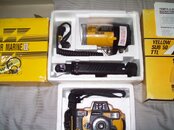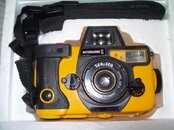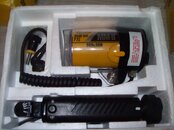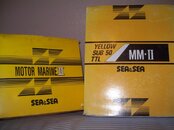Djtytanium
New
- Messages
- 1
- Reaction score
- 0
I have a Motor-Marine II with YS-50 stobe and bracket for sale... The camera and strobe have only been used once in Maui and are in great condition. Both units are still in the original boxes w/ instruction's, o-rings, and lube included. Here's a review on the camera as well as a site that displays some of the outstanding photos that have been taken with this camera, extremely professional results. Only a strobe this powerful can deliver the professional quality you desire. Camera mounted strobe alone will not be able to provide enough light. Its not digital, its film. A similar digital outfit would run over $2000. This 35mm film based outfit can produce images that could be scanned at over 20 mega-pixels. For sale for only $150.
California Diving, Motormarine II (Pre Summer 2005) Photo Gallery by Rick Coleman at pbase.com
Replacing the popular Sea & Sea Motor Marine 35SE, the very latest 35 m amphibious camera from Sea & Sea Is called the Motormarine II. Like Its predecessor, it is manufactured in smart yellow and black moulded polycarbonate and can be used to a depth of 45 metres. It is, however, noticeable larger, though not so large that It won't fit Into your ABLJ pocket, and is surprisingly light. Small depressions In the camera back mark the position your thumbs should take when using the camera and, held this way, the camera feels comfortable. Its fixed lens comprising 4 elements in 3 groups is an f3.5 35 mm lens with an aperture range of f3.5 to f16 rather than a f2.8 35 mm lens. Unlike its predecessor it has a built in close-up lens which can be dialled in to reduce the minimum focal distance from 1 metre or 39 inches to 0.5 metres or 20 inches. The 35 mm lens can be used on Its own or with the internal close-up lens both on land or underwater. Retaining a fixed mechanical shutter with a speed of 1/100th second, the exposure control of the Motormarine II Is either through the lens (TTL) or manual rather than just manual. The red shutter release on top of the camera is lockable so that you do not accidentally shoot film. The new camera Incorporates a DX film code reader which accepts either 100 ASA or 400 ASA print or slide film (other speeds of DX coded film are read as 100 ASA or 400 ASA). Film advance and rewind are motor driven, both under the control of the photographer. A useful red LED on the top of the camera flashes to confirm correct film loading. The LED display in the large viewfinder comprises a red light to warn of low light level, a green light to confirm correct TTL exposure and a yellow ready light for the built-in flash. The viewfinder incorporates two sets of framing marks, one for subjects at a distance of more than 1 metre to infinity and two parallax correction marks for subjects at 1 metre. There Is also a dot below the central "+" mark which. indicates the centre of the frame when using the built In close up lens. Using the recommended 100 ASA film - depth of field when using the close-up lens at f3. 5 and the built In flash is 0.3 - 0.6 m and depth of field when using the 35 am lens at f16 and built-in flash is 1.4 -2.9 m. BUILT-IN FLASH The built-in flash Is very slightly more powerful than that of the Motor Marine 35SE, having a land guide number of 10 (ASA/ISO 100) rather than 9. The manufacturers recommend that the built-in flash, which Is not under TTL control, is not used In depths shallower then 3 metres (to avoid overexposure) nor in murky water (to avoid backscatter). Two flash settings are available for the built-in flash, either f3.5 when using the 35 m lens or f16 when using the built-in close-up lens. Two alkaline AA batteries power the motor drive, built In flash and electronics. Although lower yielding zinc carbon AA batteries may be used, ni-cad batteries are not recommended. Access to the battery compartment is via a slotted screw on the front of the camera which when turned releases the battery pack at the bottom of the camera. The Motormarine II comes complete with a tough shoulder strap, silicone grease, spare 0-rings and batteries. EXTERNAL FLASH An external TTL flash or strobe, the YS50TTL-II, has been made specifically for the Motormarine Il. This is a very compact unit which plugs Into the side rather than the back of the camera body_via a large bulkhead connector port and can be mounted on an extendable Sea-Arm IV on a Stay V11 base plate. This base plate incorporates a guide pin to prevent swivel and is secured to the camera by a standard tripod screw. The flashgun is powered by four alkaline AA batteries which are housed in a separate watertight compartment to the electronics. As one would expect the external flash gun is more powerful than the Motormarine Ills built In flash, having a land guide number of 12 (ASA/ISO 100). A very large, clear, easy to read, exposure table for 100 and 400 ASA film dominates most of one side of the flash head. The on-off switch is mounted around the red flash-ready light at the back of the flashgun and this has a third position for TTL. Also adjacent to the battery compartment at the back of the flashgun is a green TTL correct-exposure light which stays lit for three seconds after pressing the shutter release if sufficient light has passed through the lens onto the film. The beam angle reputedly covers up to the 20 mm lens, although on test the angle was slightly less. then this, covering a circular area just less than full frame. Other Sea & See flashguns may be used with the Motormarine II via an optional bulkhead connector, BHC-II, but only in manual or slave mode. IN USE Underwater the camera is almost neutrally buoyant. so light in fact that when it was attached by the strap to my arm I was unaware of carrying the camera. I found that placing my thumb In the purpose designed depression at the back of the camera brought my trigger finger neatly over the shutter release, enabling me to hold and operate the camera easily with one hand. The built-in viewfinder was excellent, the LED display was readily visible without the need to squint at just the right angle, so that when I half-depressed the shutter release I knew straight away whether there was sufficient light and whether the flash-gun was ready to fire. Having taken a shot I also knew whether I had selected the correct exposure. The spot in the viewfinder marking the frame centre for the built in close-up lens was exactly where it should be, I personally found the aperture and distance scales on their respective controls small and difficult to read, but that's possibly due to my age! The camera is reasonably simple to use providing you read the instruction booklet first and set aperture, distance and use flash when the red LED Indicates insufficient available light. NIKONOS COMPARED How then does It compare with the widely-used Nikonos V? It Is slightly larger than the Nikonos V. but being made from moulded polycarbonate, which Is less robust, is actually lighter. The Nikonos V can be used to 50 rather than 45 metres, but then who takes worthwhile pictures at these depths? The Motormarine II is designed to be used only with 100 and 400 ASA DX coded film, whereas any film speed between 25 and 1600 ASA. coded or not, can be used with the Nikonos V. The Motormarine II has a fixed speed shutter whereas that of the Nikonos V is variable, although it only synchronises with flash at 1/30, 1/60 and 1/90th second. In low light conditions, however, the Nikonos comes into its own as it can give exposures of up to several seconds. Both cameras feature TTL flash metering. The Motormarine II has automatic film advance and rewind compared to the manual advance and rewind of the Nikonos V. The standard 35 mm lens of the Nikonos has a greater aperture range - f2. 5 to f22 - than the Motormarine II.
I have attached a few photos of the unit w/ boxes and instructions. If you are interested please send an email to DjTyTanium@aol.com.
Thanks,
Tyler
California Diving, Motormarine II (Pre Summer 2005) Photo Gallery by Rick Coleman at pbase.com
Replacing the popular Sea & Sea Motor Marine 35SE, the very latest 35 m amphibious camera from Sea & Sea Is called the Motormarine II. Like Its predecessor, it is manufactured in smart yellow and black moulded polycarbonate and can be used to a depth of 45 metres. It is, however, noticeable larger, though not so large that It won't fit Into your ABLJ pocket, and is surprisingly light. Small depressions In the camera back mark the position your thumbs should take when using the camera and, held this way, the camera feels comfortable. Its fixed lens comprising 4 elements in 3 groups is an f3.5 35 mm lens with an aperture range of f3.5 to f16 rather than a f2.8 35 mm lens. Unlike its predecessor it has a built in close-up lens which can be dialled in to reduce the minimum focal distance from 1 metre or 39 inches to 0.5 metres or 20 inches. The 35 mm lens can be used on Its own or with the internal close-up lens both on land or underwater. Retaining a fixed mechanical shutter with a speed of 1/100th second, the exposure control of the Motormarine II Is either through the lens (TTL) or manual rather than just manual. The red shutter release on top of the camera is lockable so that you do not accidentally shoot film. The new camera Incorporates a DX film code reader which accepts either 100 ASA or 400 ASA print or slide film (other speeds of DX coded film are read as 100 ASA or 400 ASA). Film advance and rewind are motor driven, both under the control of the photographer. A useful red LED on the top of the camera flashes to confirm correct film loading. The LED display in the large viewfinder comprises a red light to warn of low light level, a green light to confirm correct TTL exposure and a yellow ready light for the built-in flash. The viewfinder incorporates two sets of framing marks, one for subjects at a distance of more than 1 metre to infinity and two parallax correction marks for subjects at 1 metre. There Is also a dot below the central "+" mark which. indicates the centre of the frame when using the built In close up lens. Using the recommended 100 ASA film - depth of field when using the close-up lens at f3. 5 and the built In flash is 0.3 - 0.6 m and depth of field when using the 35 am lens at f16 and built-in flash is 1.4 -2.9 m. BUILT-IN FLASH The built-in flash Is very slightly more powerful than that of the Motor Marine 35SE, having a land guide number of 10 (ASA/ISO 100) rather than 9. The manufacturers recommend that the built-in flash, which Is not under TTL control, is not used In depths shallower then 3 metres (to avoid overexposure) nor in murky water (to avoid backscatter). Two flash settings are available for the built-in flash, either f3.5 when using the 35 m lens or f16 when using the built-in close-up lens. Two alkaline AA batteries power the motor drive, built In flash and electronics. Although lower yielding zinc carbon AA batteries may be used, ni-cad batteries are not recommended. Access to the battery compartment is via a slotted screw on the front of the camera which when turned releases the battery pack at the bottom of the camera. The Motormarine II comes complete with a tough shoulder strap, silicone grease, spare 0-rings and batteries. EXTERNAL FLASH An external TTL flash or strobe, the YS50TTL-II, has been made specifically for the Motormarine Il. This is a very compact unit which plugs Into the side rather than the back of the camera body_via a large bulkhead connector port and can be mounted on an extendable Sea-Arm IV on a Stay V11 base plate. This base plate incorporates a guide pin to prevent swivel and is secured to the camera by a standard tripod screw. The flashgun is powered by four alkaline AA batteries which are housed in a separate watertight compartment to the electronics. As one would expect the external flash gun is more powerful than the Motormarine Ills built In flash, having a land guide number of 12 (ASA/ISO 100). A very large, clear, easy to read, exposure table for 100 and 400 ASA film dominates most of one side of the flash head. The on-off switch is mounted around the red flash-ready light at the back of the flashgun and this has a third position for TTL. Also adjacent to the battery compartment at the back of the flashgun is a green TTL correct-exposure light which stays lit for three seconds after pressing the shutter release if sufficient light has passed through the lens onto the film. The beam angle reputedly covers up to the 20 mm lens, although on test the angle was slightly less. then this, covering a circular area just less than full frame. Other Sea & See flashguns may be used with the Motormarine II via an optional bulkhead connector, BHC-II, but only in manual or slave mode. IN USE Underwater the camera is almost neutrally buoyant. so light in fact that when it was attached by the strap to my arm I was unaware of carrying the camera. I found that placing my thumb In the purpose designed depression at the back of the camera brought my trigger finger neatly over the shutter release, enabling me to hold and operate the camera easily with one hand. The built-in viewfinder was excellent, the LED display was readily visible without the need to squint at just the right angle, so that when I half-depressed the shutter release I knew straight away whether there was sufficient light and whether the flash-gun was ready to fire. Having taken a shot I also knew whether I had selected the correct exposure. The spot in the viewfinder marking the frame centre for the built in close-up lens was exactly where it should be, I personally found the aperture and distance scales on their respective controls small and difficult to read, but that's possibly due to my age! The camera is reasonably simple to use providing you read the instruction booklet first and set aperture, distance and use flash when the red LED Indicates insufficient available light. NIKONOS COMPARED How then does It compare with the widely-used Nikonos V? It Is slightly larger than the Nikonos V. but being made from moulded polycarbonate, which Is less robust, is actually lighter. The Nikonos V can be used to 50 rather than 45 metres, but then who takes worthwhile pictures at these depths? The Motormarine II is designed to be used only with 100 and 400 ASA DX coded film, whereas any film speed between 25 and 1600 ASA. coded or not, can be used with the Nikonos V. The Motormarine II has a fixed speed shutter whereas that of the Nikonos V is variable, although it only synchronises with flash at 1/30, 1/60 and 1/90th second. In low light conditions, however, the Nikonos comes into its own as it can give exposures of up to several seconds. Both cameras feature TTL flash metering. The Motormarine II has automatic film advance and rewind compared to the manual advance and rewind of the Nikonos V. The standard 35 mm lens of the Nikonos has a greater aperture range - f2. 5 to f22 - than the Motormarine II.
I have attached a few photos of the unit w/ boxes and instructions. If you are interested please send an email to DjTyTanium@aol.com.
Thanks,
Tyler








